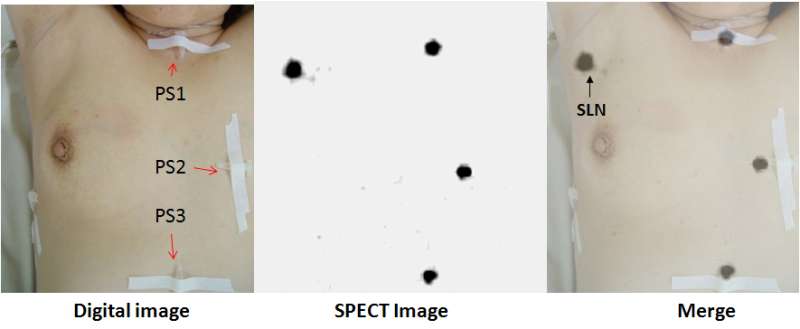Novel tracer safely and effectively maps sentinel lymph nodes in breast cancer patients

Determining whether breast cancer has spread to sentinel lymph nodes (SLN) is key to prognosis and treatment, making SLN mapping critical. The blue dyes commonly used to identify SLNs spread quickly to other nodes and is poorly retained by the SLNs (less than five minutes). This requires the surgeon to identify SLNs quickly. Allergic reaction to the dyes has also been a concern.
A recent study by researchers at Peking University Cancer Hospital & Institute, Beijing, China, demonstrates the effectiveness and safety of a new SLN radiotracer, Tc-99m-rituximab, which is well retained by SLNs. The tracer targets the antigen CD20, which is expressed extensively in lymph nodes. The study is published in the August issue of The Journal of Nuclear Medicine.
"The advantage of Tc-99m-rituximab is its uniform molecular weight and molecular size. It does not escape easily from SLNs to the second echelon lymph nodes," explains Zhi Yang, PhD, chair of the Department of Nuclear Medicine at Beijing Cancer Hospital. "This results in clear SLN imaging in patients and the high success rate of lymphoscintigraphy. In addition, technical factors, such as the injection dose, injection volume and injection site, can be well controlled."
This first study of Tc-99m-rituximab as a radiotracer for SLN imaging used lymphoscintigraphy in both preoperative and intra-operative breast cancer patients. It included 2,317 patients with primary breast cancer who underwent both lymphoscintigraphy and SLN biopsy.
In the initial study of 100 of these patients, who were randomly selected (median age 46, ranging from 27 to 73), the detection rate for SLN lymphoscintigraphy by injection of Tc-99m-rituximab was 100 percent. SLNs from the 100 patients were then harvested, guided by a hand-held gamma detecting probe, and biopsied with a success rate also of 100 percent. Of the following 2,217 patients studied, the detection/success rate was 98.8 percent for lymphoscintigraphy and 99.9 percent for SLN biopsy.
While the combination of blue dye and a radiotracer has been shown to be a superior method of detecting SLNs in breast cancer patients with an identification rate of 89 to 97 percent, this first study of the use of Tc-99m-rituximab alone demonstrates that it provides even better detection and avoids possible blue dye side effects. The tracer may have broader applications as well. Dr. Yang points out, "This radiotracer has also shown promising results in lymphoscintigraphy of melanoma."
According to the National Cancer Institute, in 2016 an estimated 246,660 new cases of breast cancer are expected to be diagnosed in U.S. women, and approximately 40,450 American women will die from breast cancer this year.
More information: N. Li et al, Clinical Evaluation of 99mTc-Rituximab for Sentinel Lymph Node Mapping in Breast Cancer Patients, Journal of Nuclear Medicine (2016). DOI: 10.2967/jnumed.115.160572















